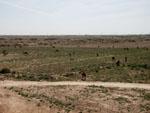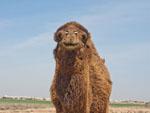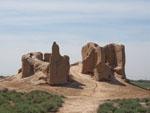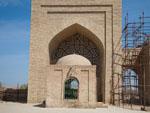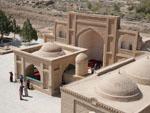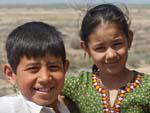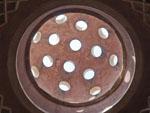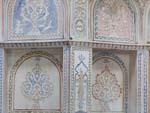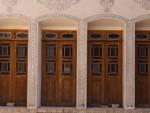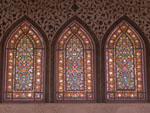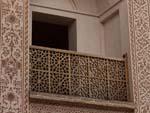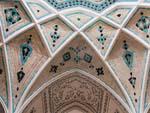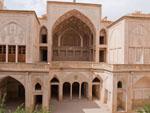We arrived in Samarkand from Khiva at 6:30am on the overnight sleeper train. While not as comfortable as the Turkmenistan train (due to lack of a cooling system), it was still a good way to travel between cities as it meant avoiding having to squeeze into a shared taxi and a bumpy ride on the pothole ridden roads of Central Asia.
thydzikgooglemap(http://sonyaandtravis.com/maps/khiva-uzbekistan-to-samarkand-uzbekistan.xml)
We headed straight to the Bohadir B&B which was in the LP, as well as being recommended to us by other travellers in Bukhara. They gave us a double with bathroom for US$9 each including breakfast, which we were happy with. We had some brekkie and headed out to explore. The B&B is located right next to Samarkand’s Registran so as we walked out we saw the breathtaking view of the Registran’s medrassas. It was noticeably cooler than it had been in Bukhara and Khiva.
We started off at the Registran but realised we need to exchange some money so headed to Siob Bazaar. It was not hard to find a money exchanger on the black market – almost every shopkeeper exchanges or knows someone who does!
Bibi Khanym Mosque
We then headed to the grandiose Bibi Khanym Mosque. It is massive at forty-one metres high. This mosque was built for Bibi Khanym, the Great Timur’s Chinese wife. Apparently the architect fell in love with Bibi and Timur had him executed. We crossed the road over to the Bibi Khanym Mausoleum which has brilliantly restored interior. The lady there offered us to climb the ‘minaret’ for 5000 Som which turned out to be the tin roof of the mausoleum, but it had great views of the Bibi Khanym Mosque and nearby Shah I Zinda.

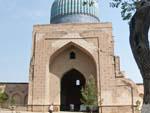










thydzikgooglemap(http://sonyaandtravis.com/maps/samarkand-uzbekistan-bibi-khanym-mosque.xml,s)
Hazrat Hizr Mosque
Next was a visit to the 8th century Hazrat Hizr Mosque, beautifully decorated in pastel colours with wooden columns.





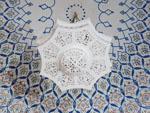



thydzikgooglemap(http://sonyaandtravis.com/maps/samarkand-uzbekistan-hazrat-hizr-mosque.xml,s)
Shah I Zinda
We headed to the spectacular Shah I Zinda, avenue of mausoleums, a truly brilliant array of mausoleums (including that of Qusam ibn Abbas, cousin of Prophet Mohammed) with beautiful tile work, mosaics – a feast for the eyes! It is a pilgrimage site and many of the tombs were covered in Som (Uzbek currency) notes.

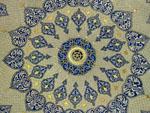




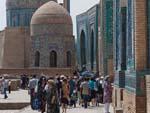


thydzikgooglemap(http://sonyaandtravis.com/maps/samarkand-uzbekistan-shahi-zinda.xml,s)
Afrosiab
An ancient Samarkand site of Afrosiab is located near to Shah I Zinda, so we decided to visit this next. While the site itself is mostly in ruins, the museum houses a 7th century fresco of KKing Vokhaouman (Sodgian period) and some Afrosiab history.
In the evening we headed back to the B&B and it started raining heavily. Thunder bellowed and lightening struck.
The Registran
The following morning we headed to the Registran, one of the most spectacular sights in Samarkand. Our B&B was just a stone throw away, so we’d walked past it a number of times but decided to explore the interior medressas on our second day. There are three magnificent medressas – the Ulugbek Medressa, named after Timur’s grandson Ulugbek, famed for his passion for astronomy and mathematics, the Sher Dor (Lion) Medressa which depict liger-like creatures (in order to align with Islamic regulations around depicting animals) which are frequently used in Uzbekistan artwork and handicrafts, and the Tilla Kari Medressa which insides contains extremely well restored mosque with its elaborately gold-decorated dome.
After we went in search of a bank (Asaka Bank) and an internet cafe, taking a walk along the streets of old Samarkand. There seemed to be a lot of restoration going on in the streets of the old town. We had lunch at a restaurant – plov, two salads and green tea.
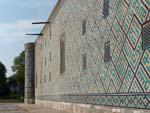









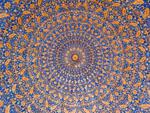













thydzikgooglemap(http://sonyaandtravis.com/maps/samarkand-uzbekistan-registan.xml,s)
Guri Amir Mausoleum
We then headed to the Guri Amir Mausoleum which contains the tombs of Timur, his sons and grandsons (including Ulugbek). We also popped into the Ak-Saray Mausoleum hidden in a back alley behind the Guri Amir.





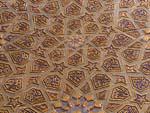



thydzikgooglemap(http://sonyaandtravis.com/maps/samarkand-uzbekistan-guri-amir-mausoleum.xml,s)
The following morning we caught a shared taxi to Tashkent, 55,000som per person for the three hour journey.






































































































































































